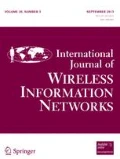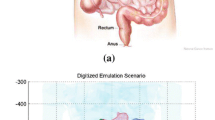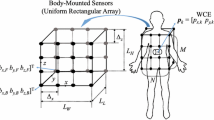Abstract
In this paper, we derive and analyze cooperative localization bounds for endoscopic wireless capsule as it passes through the human gastrointestinal (GI) tract. We derive the Cramer-Rao bound (CRB) variance limits on location estimators which use measured received signal strength (RSS). Using a three-dimension human body model from a full wave simulation software and log-normal models for RSS propagation from implant organs to body surface, we calculate bounds on location estimators in three digestive organs: stomach, small intestine and large intestine. We provide analysis of the factors affecting localization accuracy, including various organ environments, external sensor array topology, number of pills in cooperation and the random variations in transmit power of sensor nodes. We also do localization accuracy analysis for the case when transmit power of the sensor is random with known priori distribution. The simulation results show that the number of receiver sensors on body surface has more influence on the accuracy of localization than the number of pills in cooperation inside the GI tract, The large intestine is affected the most with the transmit power randomness.










Similar content being viewed by others
References
J. Oh, S. K. Shah, X. Yuan, and S. J. Tang, Automatic classification of digestive organs in wireless capsule endoscopy videos, In The 22nd Annual ACM Symposium on Applied Computing, SAC07, Soul, 2007.
M. Frisch, A. Glukhovsky, and D. Levy, Array system and method for locating an in vivo signal source, Patent US2002/0 173 718, May 20, 2002.
M. Fischer, R. Schreiber, D. Levi, and R. Eliakim, Capsule endoscopy: the localization system, Gastrointestinal Endoscopy Clinics of North America, Vol. 14, pp. 25–31, 2004.
J. R. R. Kuth and R. Rockelein, Method for determining the position and orientation of an endoscopy capsule guided through an examination object by using a navigating magnetic field generated by means of a navigation device, Patent, February 15, 2007.
M. Kawasaki and R. Kohno, A TOA based positioning technique of medical implanted services, In Third International Symposium on Medical Information & Communication Technology, ISMCIT09, Montreal, 2009.
M. Q. M. Chao Hu and M. Mandal, Efficient magnetic localization and orientation technique for capsule endoscopy, In Intelligent Robots and Systems, 2005. (IROS 2005), 2005.
A. M. Gastone Ciutia, P. Valdastria, and P. Darioa, Robotic magnetic steering and locomotion of microsystems for diagnostic and surgical endoluminal procedures, In Robotica, 2009.
S. Thomas, Smartpill redefines ‘noninvasive’, Buffalo Physician, Vol. 40, pp. 13–14, 2006.
J. H. D. Levy, R. Shreiber, A. Glukhovsky, and D. Fisher, Localization of the given M2A ingestible capsule in the given diagnostic imaging system Gastrointestinal Endoscopy, Vol. 55, p. AB135, 2002.
L. Wang, C. Hu, L. Tian, M. Li, and M. Q. H, A novel radio propagation radiation model for localization of the capsule in GI tract, In IEEE International Conference on Robotics and Biomimetics, December 19–23, 2009.
K. Arshak and F. Adepoju, Adaptive linearized methods for tracking a moving telemetry capsule, In IEEE International Symposium on Industrial Electronics (ISIE), June 2007, pp. 4–7.
K. Sayrafian-Pour, W.-B. Yang, J. Hagedorn, J. Terrill, and K. Yazdandoost, A statistical path loss model for medical implant communication channels, In 2009 IEEE 20th International Symposium on Personal, Indoor and Mobile Radio Communications, 13–16 September 2009, pp. 2995–2999.
Y. Wang, R. Fu, Y. Ye, K. Umair, and K. Pahlavan, Performance bounds for RF positioning of endoscopy camera capsules, In IEEE Radio and Wireless Week, Phoenix, Arizona, 2011.
N. Alsindi and K. Pahlavan, Cooperative localization bounds for indoor ultra-wideband wireless sensor networks, EURASIP Journal on Advances in Signal Processing, Vol. 2008, pp. 125:1–125:13, January 2008. doi:10.1155/2008/852509.
N. Bargshady, K. Pahlavan, Y. Ye, F. Akgul, and N. Alsindi, Bounds on performance of hybrid WiFi-UWB cooperative localization for robotic applications, In Proceedings of IEEE International Symposium on Personal, Indoor and Mobile Radio Communications (PIMRC10), 2010.
Ansoft Full-wave electromagnetic field simulation, http://www.ansoft.com/products/hf/hfss/, Online; accessed 27 September 2010.
N. Patwari and A. Hero, Signal strength localization bounds in ad hoc and sensor networks when transmit powers are random, In Fourth IEEE Workshop on Sensor Array and Multichannel Processing, 2006, July 2006, pp. 299–303.
K. Y. Y. H.-B. Li and B. Zhen, Wireless body area network. River Publishers, 2010.
N. Patwari, I. Hero, A.O., M. Perkins, N. Correal, and R. O’Dea, Relative location estimation in wireless sensor networks, In IEEE Transactions on Signal Processing, August 2003, pp. 2137–2148.
J. Bulat, K. Duda, M. Duplaga, R. Fraczek, A. Skalski, M. Socha, P. Turcza, and T. Zielinski, Data processing tasks in wireless GI endoscopy: image-based capsule localization and navigation with video compression, In Proc. of IEEE/EMBS, 2007, pp. 2815–2818.
H. L. V. Trees, Detection, Estimation, and Modulation Theory: Part I, Wiley, New York, 1968.
K. G. P. Swar, Y. Ye, and K. Pahlavan, On effect of transmit power variance on localization accuracy in wireless capsule endoscopy, In IEEE Wireless Communications and Networking Conference (WCNC 2012), Paris, 2012.
Acknowledgments
The authors would like to express their acknowledgements to Dr.Kaveh Ghaboosi, Umair Khan, Ruijun Fu, Dr. Nayef Alsindi and other colleagues in CWINS lab in preparing of this paper. And the National Institute of Science and Technology (NIST) for funding support on this paper.
Author information
Authors and Affiliations
Corresponding author
Rights and permissions
About this article
Cite this article
Ye, Y., Swar, P., Pahlavan, K. et al. Accuracy of RSS-Based RF Localization in Multi-capsule Endoscopy. Int J Wireless Inf Networks 19, 229–238 (2012). https://doi.org/10.1007/s10776-012-0193-1
Received:
Accepted:
Published:
Issue Date:
DOI: https://doi.org/10.1007/s10776-012-0193-1




